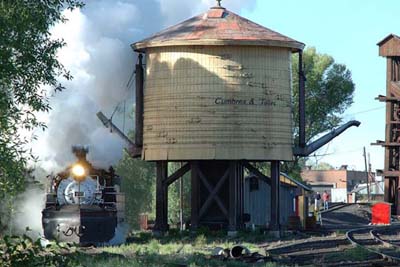Wood And Water Station on:
[Wikipedia]
[Google]
[Amazon]


 A water stop or water station on a railroad is a place where steam trains stop to replenish water. The stopping of the train itself is also referred to as a "water stop". The term originates from the times of
A water stop or water station on a railroad is a place where steam trains stop to replenish water. The stopping of the train itself is also referred to as a "water stop". The term originates from the times of
p. 81
/ref>


 A water stop or water station on a railroad is a place where steam trains stop to replenish water. The stopping of the train itself is also referred to as a "water stop". The term originates from the times of
A water stop or water station on a railroad is a place where steam trains stop to replenish water. The stopping of the train itself is also referred to as a "water stop". The term originates from the times of steam engine
A steam engine is a heat engine that performs mechanical work using steam as its working fluid. The steam engine uses the force produced by steam pressure to push a piston back and forth inside a cylinder. This pushing force can be trans ...
s when large amounts of water were essential. Also known as wood and water stops or coal and water stops, since it was reasonable to replenish engines with fuel
A fuel is any material that can be made to react with other substances so that it releases energy as thermal energy or to be used for work. The concept was originally applied solely to those materials capable of releasing chemical energy but ...
as well when adding water to the boiler.
During the very early days of steam locomotives, water stops were necessary every 7–10 miles (11–16 km) and consumed much travel time. With the introduction of tender
Tender may refer to:
Entertainment Film
* ''Illegal Tender'' (2007), a film directed by Franc. Reyes
* ''Tender'' (2012), a short film by Liz Tomkins
* ''Tender'' (2019), a short film by Darryl Jones and Anthony Lucido
* ''Tender'' (2019), a sh ...
s (a special car containing water and fuel), trains could run 100–150 miles (160–240 km) without a refill.
To accumulate the water, water stops employed water tanks, water towers and tank ponds. The water was initially pumped by windmills, watermills, or by hand pump
Hand pumps are manually operated pumps; they use human power and mechanical advantage to move fluids or air from one place to another. They are widely used in every country in the world for a variety of industrial, marine, irrigation and leis ...
s often by the train crew themselves. Later, small steam and gasoline engines were used.
As the U.S. railroad system expanded, large numbers of tank ponds were built by damming various small creeks that intersected the tracks in order to provide water for water stops. Largemouth bass were often stocked in tank ponds.
Many water stops along new railways evolved into new settlements. When a train stopped for water and was positioned by a water tower, the boilerman
A fireman, stoker or watertender is a person whose occupation it is to tend the fire for the running of a boiler, heating a building, or powering a steam engine. Much of the job is hard physical labor, such as shoveling fuel, typically coal, into ...
swung out the spigot
A tap (also spigot or faucet: see usage variations) is a valve controlling the release of a liquid or gas.
Nomenclature
United Kingdom
* Tap is used in the United Kingdom and most of the Commonwealth for any everyday type of valve, partic ...
arm over the water tender and "jerked" the chain to begin watering. This gave rise to a 19th-century slang term "Jerkwater town" for towns too insignificant to have a regular train station. Some water stops grew into established settlements: for example, the town of Coalinga, California, formerly, ''Coaling Station A'', gets its name from the original coal stop at this location. On the other hand, with the replacement of steam engines by diesel locomotive
A diesel locomotive is a type of railway locomotive in which the prime mover is a diesel engine. Several types of diesel locomotives have been developed, differing mainly in the means by which mechanical power is conveyed to the driving whee ...
s many of the then obsolete water stops, especially in deserted areas, became ghost towns.
During the days of the Wild West, isolated water stops were among the favorite ambush places for train robber
Train robbery is a type of robbery, in which the goal is to steal money or other valuables being carried aboard trains.
History
Train robberies were more common in the past when trains were slower, and often occurred in the American Old West. Tr ...
s.Roy R. Roberg, Jack L. Kuykendall (1993) "Police & Society", Wadsworth Pub. Co. p. 81
/ref>
Notes
References
See also
* Track pan (water trough) *Water crane
A water crane is a device used for delivering a large volume of water into the tank or tender of a steam locomotive. The device is also called a water column in the United States and Australia. As a steam locomotive consumes large quantities of ...
{{DEFAULTSORT:Water Stop
Rail infrastructure
Water supply
Steam locomotive technologies